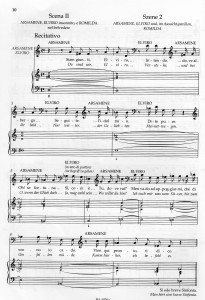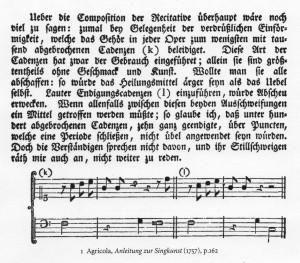
Posted by Chad Cygan on Mar 3, 2011 in
Class Presentation |
1 commentGutknecht, Dieter. “Performance Practice of Recitativo secco in the first half of the 18th Century…particularly in Handel’s Operas.” EM 23/3 (2005):473-93.
This particular article deals exclusively with the options in performing cadences after a singer has completed a line of recitativo secco in (mostly) Handel’s operas.
Performance Practice of
recitativo secco in the first half of the 18th century can entail many things, however today’s discussion will entail mostly one aspect of that:
Cadences
THE PROBLEM:
The disagreements addressed in this article deal mainly with the convention cadential notation in modern editions, which varies often from autograph scores.

Serse/Xerxes HWV 40 (1738)
The score to the left illustrates current publishing practice in the Bärenreiter edition.
Note how the final bar contains music for the Arsamene to sing Eb-Eb on the final two syllables of his phrase. The supplied harmony below it would create a dissonance the first of these two syllables with the singer holding Eb and the sustained harmony of a Bb major chord.
In this particular case the cadence can be performed several ways:
-
1. Clausula truncata: it is delayed to avoid the dissonance between singer and harmony.
-
2. Clausula formalis: It can occur simultaneously with the dissonance present with the singer.
(In this case an appogiatura to avoid the dissonance is not viable due to resultant parallel octaves.)
Theorists’ Early Perspectives on Recitative:
Friedrich-Heinrich Neumann offered this critique for performative options:
(a) Generally, they should be played after the beat; e.g. the instrumentalist was supposed to wait to play his final chords ‘until after the singer had completely closed the period’.
(b) According to some theorists, ‘The bass accompaniment in operas, [however], was already supposed to come in during the singer’s [penultimate] note, even if this was not harmonically correct.
(c) In any case, both final chords were to be struck very short and with no arpeggio.
Through another analysis of this performance practice problem Sir Jack Westrup, through quoting Heinichen, offers other solutions through alternative harmonization:

Agricola Example
The views Westrup draws from were originally published in Heinichen’s Der Generalbass in der Komposition (Dresden, 1728). While a good discussion of his suggestions can be found in the original article, let it suffice here to say that exceptions were noted to all of the rules he listed, “as freedoms which have been made use of so often that they have acquired the status of citizens’ rights”.
Mattheson, who inserted his own commentary into Heinichen’s work still notes that other opinions on how to resolve this ‘issues’ should be encouraged.
Ironically Heinichen’s suggestions avoid the unresolved dissonance in the first chord found in these cadences. This may be due to his view of slowing the drama of these works to be worse than tolerating momentary dissonance.
Only in final cadences did Heinechen suggest delaying the cadential resolution to avoid the dissonance; this was clearly in contrast with his view of how to handle inner cadences.
Moderation and Compromise – The Performer’s View
Later theorists and one singer, former castrato Pier Francesco Tosi (1654-1732), took Heinechen’s ideas even further. Instead of tolerating delays when performing inner cadences Tosi preferred a less ‘maddening uniformity’ of interpretation. Agricola took Tosi’s view further and finally made this an issue of practice in performance, instead of in theory.
The idea of boredom was what moved Agricola-Tosi to comment on this and even to suggest that inner cadences end on 6-3 chords instead root position.
Sven Hansell and Winston Dean argued against this view claiming that cadences were finalis prior to 1750 and tronche after this year. Citing Handel’s manuscript notation they both indicated that exceptions to this rule should only be made when emphasizing words that require great weight. Clearly thier reasoning was not based on performance practice, but rather the composer’s intentions, in their interpretation. Dean also argued that the resulting dissonances would not sound as striking when performed on period instruments.

Handel's Messiah, HWV 56 (1741)
Let’s take a look at this kind of interpretation in Handel’s Messiah to see if this same approach to recitative holds true in his oratorios.
In the final bar of this soprano accompagnato Handel’s cadence is often delayed, in current performances. Yet, according to Hansell and Dean it should be performed without delay, even though it is not part of a recitativo secco.
According to that same theory the attack of No. 13 should be immediate following the singer’s final note on ‘night’ in the first system, final measure.
How does this sit with you as a performer? If you don’t like this interpretation, can you offer a different alternative?
[youtube]http://www.youtube.com/watch?v=ifGcm15Owu4[/youtube]
This sequence of endless recitatives is also from Messiah, but listen and discuss the choices taken by the performers and discuss:
What types of cadential choices worked in this example? Which did not?
Finally, Monson cited manuscripts of other composers around the same time as Handel and claimed that Italian manuscripts tended to contradict this view of not delaying cadences. In fact the majority of these scores demonstrate delayed cadences, yet this article lacks definitive score examples showing precisely how this was determined.
Monson’s conclusions covered many bases, but it seems his most important one was that notation on the beat was conventional, however it was still conceivable that these were performed as delayed cadences anyhow.
What Would Handel Do?
In his extensive conclusion to this article Gutknecht compares Handel’s pasticcios based closely on Italian models and compares his interpretations with various Italian composers. Throughout his vast analysis almost all of the approaches previously listed by theorists, composers and singers were implemented.
The most intriguing discovery was that Handel varied most from Gasparini in their respective settings of Bajazet and Tamerlano in their changes to the vocal approach of cadences. Handel tends to approach the vocal and textual meaning in a manner that avoids many of the pitfalls, particulary that of dissonances, by changing the interval with which the singer ends their phrases.
Dissonance
To avoid dissonance, Handel began to displace many of his cadential figures using rests to clearly specify this. Handel also varied the beats upon which he would place his dominant-tonic resolutions in a way that other composers had not. Due to these, and other, issues performance editions have begun to appear in which appoggiaturas are not notated (sometimes suggested) allowing the singer the chance to alter the harmony and provide, or remove dissonances.
Internal Cadences
While Handel has been found to utilize the resolution to a 6-3 chord in many internal cadences, he leaves no directions about how to perform varations from the norm. In Agrippina in particular he chose to sway from the Italian model, but all he left were questions of interpretation.
Instrumentation
Another question raised in this article was that of instrumentation for accompanying secco recitatives. Handel specifically lists the instrument which are not supposed to join in the accompaniment, however he conspicuously does not list specific instrument which should. The variations in accompanying ensemble can have many effects upon interpretation of these musical events, but this article supplies not specific conclusion.
CONCLUSIONS:
Gutknecht cites many recordings in his assessment of the validity of the views he has presented and seems very intrigued by the arguments without taking a specific side on the matter. Wihtout actually discussing singers I do find it interesting that he can feel this article is complete, but his closing paragraph holds great interest:
“Both national conventions and remarks by musical theorists suggest that 18th-centruy cadential execution was considerably more varied than is the case in current musical practice”.
















I was amaze with the article..really helps.